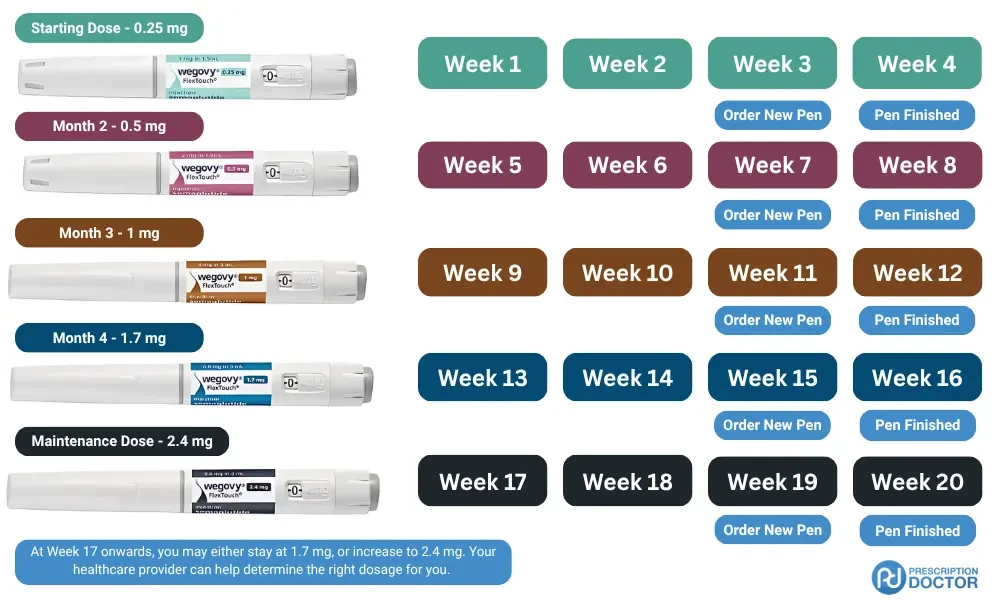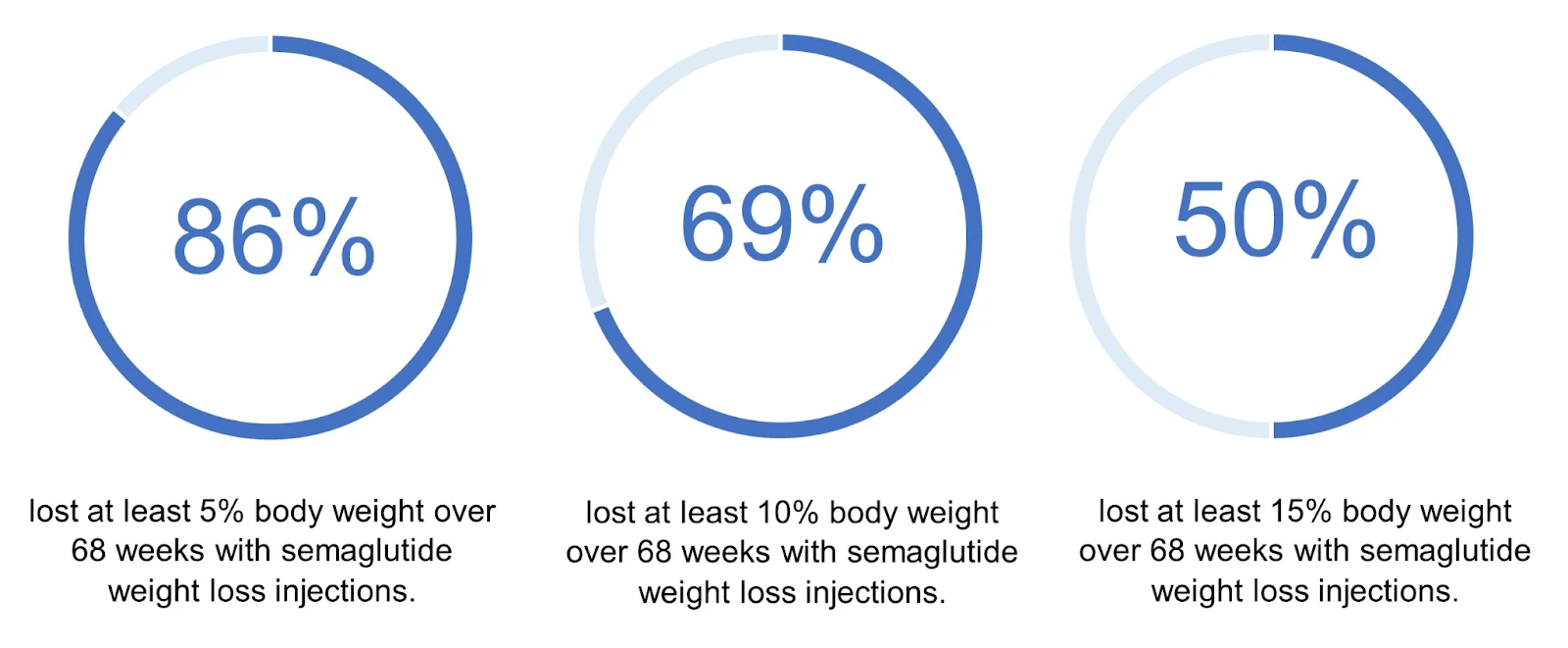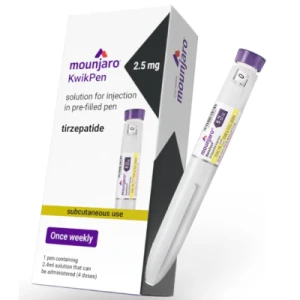How Does Wegovy (Semaglutide) Work?
Table of contents:
- Wegovy: What is it Used for?
- How Does Wegovy Work for Weight Loss?
- How to Use the Wegovy Pen
- What is the Average Weight Loss on Wegovy?
- What Can Affect Wegovy Weight Loss Results?
- What Dose of Wegovy is Most Effective?
- Wegovy Weight Loss: Before and After
- Wegovy or Mounjaro: Which is Better?
- Which is Better: Wegovy or Ozempic?
- Other Alternatives to Wegovy
- Kick-Start Your Wegovy Weight Loss Journey with Prescription Doctor
If you’re exploring weight loss options, you may have come across Wegovy, an injectable treatment that has been proven to enhance results when paired with a healthy diet and regular exercise. But how does Wegovy work, and why should you consider adding it to your regimen?
In this guide, we’ll provide you with everything you need to know about Wegovy, such as how it’s used, the dosing schedule, and the results you could achieve. Whether you’re debating trying weight loss medication or are exploring available treatment options, keep reading to discover why Wegovy could be a powerful ally as you embark on your journey.
Start Your Wegovy Consultation
Wegovy: What Is It Used For?
Wegovy is a prescription-only medication that’s primarily used for weight loss in people who are obese or overweight and have related health conditions, like high blood pressure, type 2 diabetes, or high cholesterol. Wegovy contains the active ingredient, semaglutide, and belongs to a class of medications called glucagon-like peptide 1 (GLP-1) agonists.
GLP-1 receptor agonists work by regulating your appetite and food intake, leading to weight reduction. Wegovy contains the same active ingredient as another GLP-1 receptor agonist called Ozempic. However, Ozempic and Wegovy are different in that only Wegovy is licensed for weight loss in the UK.
Anyone wanting to try Wegovy for weight loss will need to meet the following eligibility criteria:
- a body mass index (BMI) of 30 or above, or
- a BMI of at least 27 and at least one weight-related health condition like high blood pressure or type 2 diabetes
Wegovy is available with a private prescription from trusted online pharmacies, such as Prescription Doctor, and on the NHS for those who need it most.
How Does Wegovy Work for Weight Loss?
Wegovy’s active ingredient, semaglutide, works by mimicking the natural hormone GLP-1, which is crucial for regulating appetite, blood sugar levels, and insulin release. By binding to the GLP-1 receptors in the brain, Wegovy controls your hunger and appetite, making it an effective weight loss medication.
Wegovy supports weight loss by:
- Controlling your appetite
- Slowing down digestion
- Reducing cravings
- Regulating blood sugar levels
.webp)
As your dose of Wegovy increases, you’ll notice your appetite reducing and that you have fewer cravings. Because you feel more satisfied with smaller meals and less food, you’ll enter a calorie deficit (eating fewer calories than you burn), which, combined with other healthy lifestyle changes, contributes to weight loss.
Wegovy also regulates blood glucose levels and stimulates the release of insulin from the pancreas, which is particularly useful for people with type 2 diabetes. These mechanisms are what make Wegovy an effective and multifaceted treatment for weight loss and your wider metabolic health.
How to Use the Wegovy Pen
Wegovy is administered via a once-weekly subcutaneous (under the skin) injection. Each pen is pre-filled with four doses of semaglutide, so there’s no complicated drawing up procedure. You’ll start on the lowest Wegovy dose of 0.25 mg per week, which is gradually increased over 16 or 20 weeks until you reach the maintenance dose that’s most effective and comfortable.

Wegovy can be injected into your:
- Stomach: Ensure it is at least 2 inches away from your belly button.
- Thigh: Choose a different area each time to avoid irritation and scarring
- Upper arm: It’ll need to be injected at the back of your arm, and you’ll likely need someone to help you.
You can find out more about how to use Wegovy in our dedicated guide.
What is the Average Weight Loss on Wegovy?
Although the average weight loss on Wegovy can vary, clinical trials show that patients can lose up to 15% of their starting body weight at the highest dose over 68 weeks. However, weight loss is a personal journey, and your own results may differ due to various factors, including diet, exercise, and existing health conditions.
Additionally, 66% of people who received the treatment lost at least 10% of their body weight, compared to just 12% of people given a placebo. At the same time, 30% of people dropped at least 20% of their body weight compared to just under 2% of people on a placebo.

A study comparing the effectiveness of semaglutide (Wegovy) and another popular weight loss medication, liraglutide (previously known as Saxenda), found that the average weight loss was greater in the Wegovy group (15.8%) than the Saxenda group (6.4%) over 68 weeks.
Wegovy works best when used in conjunction with healthy lifestyle changes, such as a calorie-controlled diet and regular exercise. Most people will start to notice results within the first few weeks of treatment, but the most noticeable weight loss occurs after 3 to 6 months. Be patient with your progress, as some people may see results faster than others. Remember, it’s not a race.
What Can Affect Wegovy Weight Loss Results?
Wegovy should never be considered as a quick-fix solution. In fact, there is no such thing as a miracle weight loss treatment. So, it will take a considerable amount of effort, perseverance and patience to reach your goals, and Wegovy can make the journey a little easier. However, several factors can impact Wegovy weight loss, including:
- Diet and exercise: Wegovy works best when used alongside a reduced-calorie diet and increased exercise, inducing a calorie deficit — burning more calories than you consume. When you start Wegovy treatment with Prescription Doctor, you’ll gain access to expert advice and resources, including a Wegovy diet plan, to help you maximise the benefits of the medication.
- Underlying health conditions: If you already have an underlying medical condition like an underactive thyroid (hypothyroidism) or a hormonal imbalance, it can make it more challenging to lose weight. Getting appropriate treatment for these may improve your weight loss results.
- Age: Unfortunately, as you age, your metabolism inevitably slows down, which can bring about weight loss challenges. However, weight loss isn’t impossible as you get older; it just means it may take a little longer. So, be patient with your body — remember, good things come to those who wait.
- Wegovy dose: It’s essential to gradually increase to the Wegovy maintenance dose that’s most suitable for you, aiming to minimise the risk of side effects. However, it also means that you may not start to notice a big difference in your weight for a few weeks or even months. Weight loss occurs in stages, so adhere to the Wegovy dosage plan and avoid missing doses for optimal results.
- Not the right medication for you: Wegovy may not be the most effective weight loss medication for everyone. If it doesn’t lead to the desired results, or if the side effects are too bothersome, you may need to explore different weight loss medications.
That said, there are several things you can do to support your weight loss journey and maximise the effect of weight loss injections. Here are 5 ways to increase weight loss with Wegovy.
Wegovy
- Approved Weight Loss treatment
- Weekly injection
- Reduces risk of heart attack & stroke
What Dose of Wegovy is Most Effective?
Clinical trials show that the highest dose of Wegovy, 2.4 mg per week, is the most effective dose for weight loss. However, this is an average, and the most effective Wegovy dose for you will depend on your individual needs and how well your body tolerates semaglutide.
Results from the STEP 1 trial show the following:
Week | Dose (mg) | Average Weight Loss |
|---|---|---|
4 | 0.25 | ≈ 2% |
8 | 0.5 | ≈ 4% |
12 | 1.0 | ≈ 6% |
16 | 1.7 | ≈ 8% |
20 | 2.4 | ≈ 10% |
While the higher doses may be more effective for weight loss, they also increase the risk of Wegovy side effects. That’s why it's essential to increase the dose gradually over several weeks, allowing a clinician to monitor how your body tolerates the medication. Some people get great results on lower doses, too, so if you feel that a less potent Wegovy dose is working for you, speak to your clinician about sticking with it.
Wegovy Weight Loss: Before and After
Wegovy has produced some impressive weight loss transformations in both clinical trials and in the real world. These dramatic before-and-after results have been shared by many users, providing a clearer idea of what to expect with Wegovy treatment.
Whether your goal is to smash your weight loss goals out of the park, improve your metabolic health, gain confidence, or a combination of all three, our patients share their stories to show you just how possible this is with Wegovy.
Wegovy or Mounjaro: Which is Better?
Mounjaro is generally considered to be more effective than Wegovy for weight loss. Clinical trials have shown that Mounjaro could help you lose 21% of your body weight after 18 months, compared to 15% in 17 months on Wegovy. However, everyone’s experiences are different, so it’s important to carefully compare both options to find the best fit for you.
One factor to consider when choosing between Wegovy or Mounjaro is how well you cope with the various side effects each medication can cause. For example, research has shown that approximately 4% of people stop taking Wegovy due to side effects, compared to around 7% of Mounjaro users.
Mounjaro
- Approved Weight Loss Treatment
- Suitable for adults with a BMI of +30kg/m²
- Pre-filled injection pen
If you have any underlying health conditions, you may also find that one medication works better for you than the other. A registered clinician will be able to review your options and recommend the course of action they believe is best.
Which is Better: Wegovy or Ozempic?
Wegovy and Ozempic are both GLP-1 receptor agonists that contain the same active ingredient, semaglutide, but they are prescribed for different purposes. Ozempic works in the same way as Wegovy, but only the latter is licensed for weight loss, while the former is prescribed for type 2 diabetes and managing very high blood sugar levels in the UK.
Wegovy
- Approved Weight Loss treatment
- Weekly injection
- Reduces risk of heart attack & stroke
While it’s true that Ozempic patients do indeed lose weight, Wegovy is prescribed in higher doses and formulated specifically for weight loss, making it more effective for this purpose. At Prescription Doctor, we will always recommend Wegovy for weight loss, not Ozempic.
Other Alternatives to Wegovy
Although it is an effective and convenient weight loss medication, Wegovy may not be suitable for everyone. You may have health conditions that are incompatible with semaglutide, or your body may not tolerate Wegovy well, resulting in unpleasant side effects. Whatever the reasons, alternative weight loss treatments are available, including prescription options like orlistat and MySimba or over-the-counter pills like Alli.
The main Wegovy alternatives available from Prescription Doctor are:
- Orlistat: A generic version of Xenical that works by blocking the absorption of fat from the food you eat, so that it passes out of your body as waste in your stools. It is a pill containing 120 mg of orlistat and can be taken up to 3 times a day with fat-containing meals. With orlistat (Xenical), 37% of people lost 5% or more of their starting body weight after 12 weeks, compared to 19% of people given a placebo.
- MySimba: An appetite suppressant in the form of a pill that contains two active ingredients, naltrexone and bupropion. It’s considered one of the strongest weight loss pills, alongside orlistat. MySimba is only available with a private prescription in the UK and is not available on the NHS. The average weight loss on MySimba is 8.1% after 56 weeks.
- Alli: An over-the-counter version of Xenical (orlistat) that’s available from most high street pharmacies and online. It contains orlistat and works in exactly the same way as Xenical, but contains half the dose (60 mg) of the active ingredient.
- Saxenda: A daily weight loss injection that acts as a GLP-1 agonist to suppress your appetite and support weight loss. It contains the active ingredient, liraglutide, but is currently out of stock.
Kick-Start Your Wegovy Weight Loss Journey with Prescription Doctor
Now that you have a better idea of how Wegovy works, you may think that you’d benefit from adding this medication to your diet and exercise plans. If this is the case, Prescription Doctor is here to help and provide you with all the support you need to embark on your weight loss journey with confidence.
Complete our online health consultation, and our registered clinicians will determine if Wegovy is suitable for your needs. They’ll assess your medical history and individual circumstances and either issue your prescription or recommend an alternative weight loss treatment. We provide a completely personalised experience.
With the consultation complete, we could deliver your medication the very next day, using discreet packaging that ensures a private and confidential service.
We’ve been helping people just like you since 2013 to achieve their weight loss goals, and the fact that our dispensing pharmacy is registered with the General Pharmaceutical Council (GPhC) means you can be completely confident that you’re in safe hands.
Ready to kick-start your journey to a healthier you? Start your Wegovy consultation today.
Sources
- emc, (2025). Mounjaro KwikPen 2.5mg solution for injection in pre-filled pen.
- emc, (2024). Wegovy 0.25 mg, FlexTouch solution for injection in pre-filled pen
- emc, (2023). Mysimba 8 mg/90 mg prolonged-release tablets
- emc, (2023). Xenical 120 mg hard capsules
- JAMA, (2022). Effect of Weekly Subcutaneous Semaglutide vs Daily Liraglutide on Body Weight in Adults With Overweight or Obesity Without Diabetes
- NEJM, (2022). Tirzepatide Once Weekly for the Treatment of Obesity
- NEJM, (2021). Once-Weekly Semaglutide in Adults with Overweight or Obesity
Authored By

Leanne Edermaniger
Medical Content WriterPublished on: 14/09/2023
Reviewed By

Mohamed Imran Lakhi
MPharm - Lead PharmacistReviewed on: 05/06/2025
© 2013 - 2026 Al Muhsineen Limited. All Rights Reserved. Registered Pharmacy: 34 Halliwell Road, Bolton BL1 8RL. Registered Office: 254 First Floor, Shearbrow, Blackburn, England, BB1 8DS







